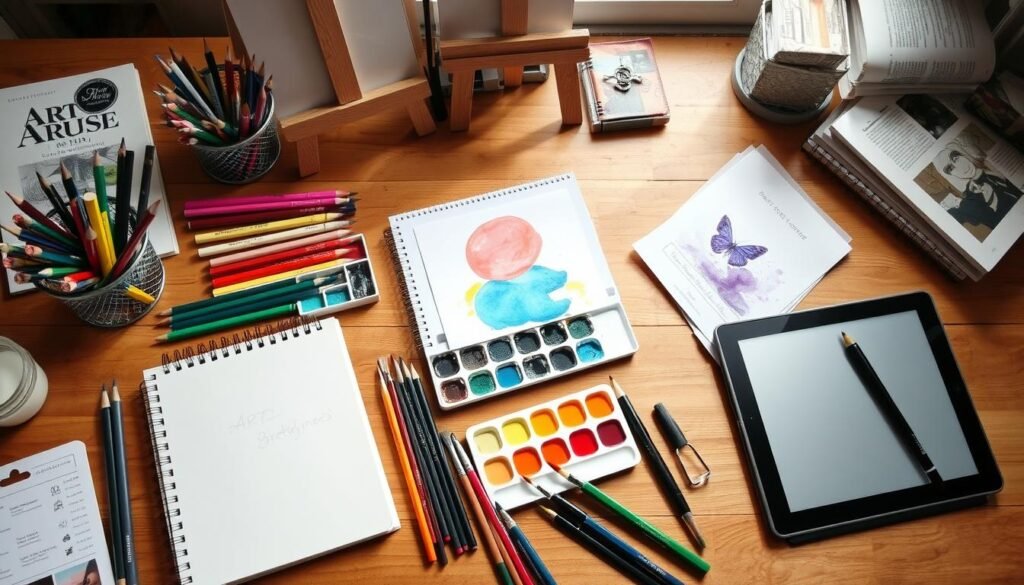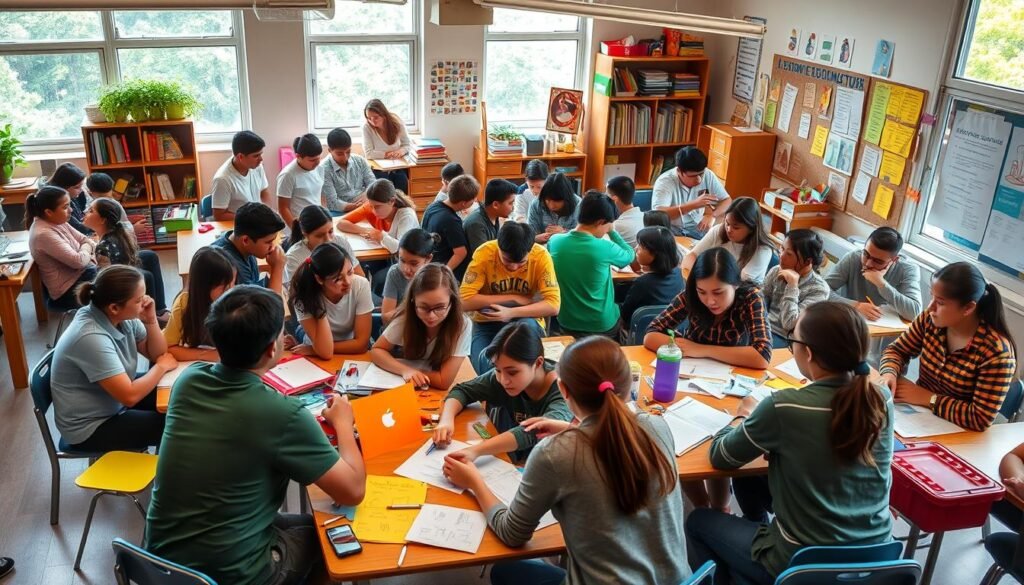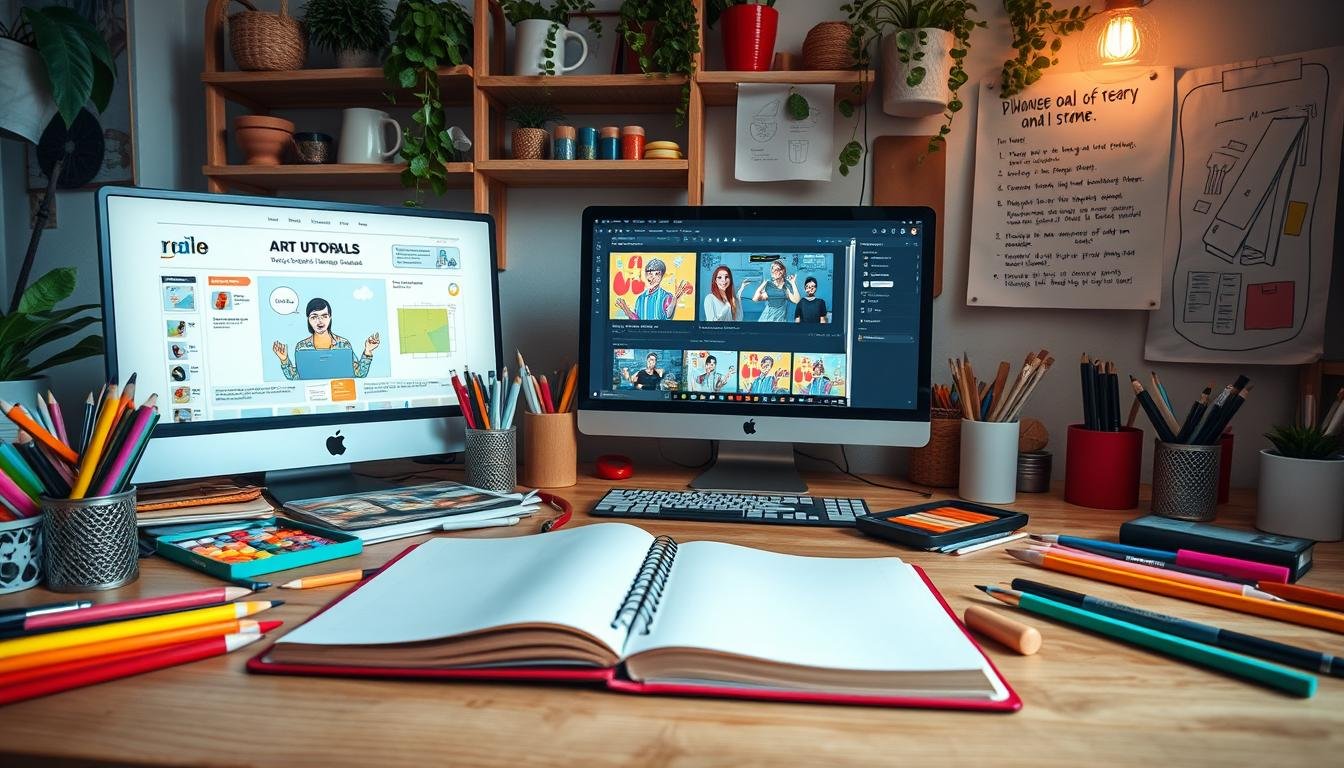Do you remember the excitement of starting to sketch with a pencil? Or the thrill of mixing colors to capture a sunset? We’ve all felt that spark of creativity, ready to bring our ideas to life. Step-by-step tutorials offer a helping hand, guiding us through new skills.
Imagine having a patient friend to break down complex tasks into simple steps. That’s what instructional guides do for you. They act as your personal mentors, always there to guide you through each step of your learning journey. Whether you’re starting with watercolors or your first DIY project, these guides are your go-to resource.
Did you know 50% of tutorials are labeled ‘easy’? That means half of the resources out there are perfect for beginners like you. With more beginner tutorials than intermediate ones, you’ll have plenty of room to grow as you learn.
From drawing basic shapes to creating specific paintings like “Autumn Reflections” or “The Great Pumpkin,” how-to manuals open up a world of possibilities. They’re not just instructions; they’re invitations to explore, create, and surprise yourself with what you can do.
Key Takeaways
- Step-by-step tutorials break complex tasks into manageable chunks
- 50% of tutorials are designed for beginners
- Visual walkthroughs enhance learning across various skills
- Instructional guides cater to different learning styles
- Regular practice is key to skill improvement
- Tutorials cover a wide range of topics from arts to DIY projects
Understanding the Power of Step-by-Step Tutorials
Step-by-step tutorials change the way we learn. They make complex tasks easy to follow. This method helps you learn new skills step by step, building confidence as you go.
Breaking Complex Tasks into Manageable Chunks
Tutorials make hard tasks simple. They break them down into smaller steps. This way, you can easily follow along and complete projects without feeling lost.
For example, a 218-step tutorial for beginners might look tough at first. But, when you break it down, it becomes more manageable.
Building Confidence Through Gradual Learning
As you work through tutorials, you’ll feel more confident. Each step you finish is a win, pushing you to keep going. This slow and steady approach is great for personal growth and development.
Catering to Diverse Learning Styles
Tutorials fit different learning styles. Whether you like pictures or hands-on activities, there’s something for you. They use text, images, and exercises to help you understand fully.
“Time, effort, and discipline are the three essential ingredients for learning any skill or knowledge.”
Success with tutorials comes from practicing regularly. By following along, you’re not just memorizing steps. You’re building a strong base for future learning and skill growth.
Getting Started: Essential Tools for Following Tutorials
Starting your learning journey needs the right tools. Whether you’re into coding or creative arts, having the right gear is key. It makes sure you get the best from your tutorials.

A reliable computer or tablet is a must for digital learning. You’ll also need a notepad and pen for jotting down important points. For those who learn better with pictures, a sketchbook and drawing tools are great.
| Tool Category | Examples | Purpose |
|---|---|---|
| Writing Tools | Pens, pencils, notebooks | Taking notes, sketching ideas |
| Digital Devices | Computer, tablet, smartphone | Accessing online tutorials, practicing digital skills |
| Art Supplies | Sketchbook, colored pencils, markers | Following creative tutorials, visual learning |
| Software | Text editors, design programs | Practicing coding, graphic design |
Don’t forget to set up a comfy workspace. Good lighting and an ergonomic chair can really help your learning. The right tools can make you feel more confident and help you pick up new skills easily.
“The right tool for the right job makes all the difference in learning new skills.”
Step-by-Step Tutorials: A Gateway to Learning Anything
Starting new skills can feel overwhelming, but step-by-step tutorials make it easier. They break down hard tasks into smaller parts. This lets you learn at your own speed.
Exploring Various Tutorial Formats
DIY tutorials come in many styles for different ways of learning:
- Written guides with clear instructions
- Video demonstrations showing real-time processes
- Interactive lessons for hands-on practice
- Visual walkthroughs with step-by-step images
Finding the Right Tutorial for Your Skill Level
Pick tutorials that fit your skill level. Beginners should start with simple ideas. Advanced learners can try harder projects. It’s fine to go back to basics to get a better grasp.
Setting Realistic Expectations and Goals
When using DIY tutorials, set goals you can reach. Begin with small tasks and slowly add more complexity. Celebrate your wins along the way. Remember, getting good takes time and effort.
| Tutorial Planning Steps | Key Considerations |
|---|---|
| Define Learning Outcomes | What students should achieve |
| Allocate Flexible Time | For each tutorial activity |
| Encourage Participation | Avoid ‘mini-lectures’ |
| Consider Student Diversity | Different experiences and motivations |
| Plan Resources | Pre-tutorial and in-tutorial materials |
| Provide Feedback | Guide future tutorials |
| Support Learning Requirements | Adjustments for disabled students |
By following these steps, you’ll get the best out of your tutorial learning. Remember, regular practice and patience are crucial. They help you master new skills through DIY tutorials and visual walkthroughs.
Mastering the Art of Following Instructions
Learning to follow instructions starts early and lasts a lifetime. It’s key for success in many areas of life. From simple tasks for kids to complex ones for adults, it’s vital to get it right.

Cooking, baking, and science experiments are great for practicing step-by-step instructions. These activities teach the value of following procedures. They also help you learn from mistakes when you don’t get it right.
“Breaking down instructions into smaller steps aids understanding and improves the ability to follow them effectively.”
For kids, games like ‘Simon Says’ and treasure hunts make following instructions fun. As they get older, putting together toys and learning new games helps too. Adults face the challenge of staying focused and patient with complex instructions in our fast-paced world.
| Age Group | Instruction-Following Activities | Benefits |
|---|---|---|
| Toddlers | Simple one-step directions, cooking tasks | Develops basic life skills, enhances math abilities |
| Children | Science experiments, baking, game rules | Improves comprehension, fosters independence |
| Adults | Complex procedural documentation, online courses | Enhances career skills, supports lifelong learning |
In school, task-based learning helps students get better at following instructions. But, it can be tough to remember things and handle many tasks at once. To get past these hurdles, be patient, simplify complex tasks, and really get into the learning.
Popular Categories for Beginner-Friendly Tutorials
Step-by-step tutorials open up a world of learning opportunities. Let’s explore some popular categories where beginners can find easy-to-follow how-to manuals and instructional guides.
Creative Arts and Crafts
Unleash your artistic side with tutorials on painting, drawing, and crafting. Learn techniques for autumn-themed projects like creating reflections or painting pumpkins. Try your hand at drawing animals or cartoon characters using simple guides.
Technology and Software Skills
Dive into the digital world with tech tutorials. Learn to code with Python, build mobile apps with Kivy, or create games using Pygame. Explore data science concepts or automate tasks with practical instructional guides.
Cooking and Baking Basics
Whip up delicious meals and treats with step-by-step recipes. Master cooking techniques and baking fundamentals. From simple dishes to complex culinary creations, these tutorials will guide you through each stage.
DIY Home Improvement Projects
Transform your living space with home improvement tutorials. Learn to paint, repair, or build furniture. Tackle projects like creating a fall-themed mailbox or installing smart home devices using detailed how-to manuals.
| Category | Example Tutorial | Skills Learned |
|---|---|---|
| Creative Arts | Painting Autumn Reflections | Color mixing, brush techniques |
| Technology | Building a Weather App with Python | Coding, API integration |
| Cooking | Baking Perfect Chocolate Chip Cookies | Measuring, mixing, baking times |
| DIY Home Improvement | Installing a Smart Thermostat | Wiring, programming, energy efficiency |
Overcoming Common Challenges in Tutorial-Based Learning
Tutorials can be rewarding, but they come with challenges. Beginners often get frustrated with mistakes or hard concepts. It’s important to see these challenges as chances to grow, not obstacles.
Learning from mistakes is key. Each mistake helps you get better and understand more. With regular practice, you’ll improve your skills. Remember, even the best started where you are now.
To make tutorials work better for you, try these tips:
- Break complex tasks into smaller, manageable steps
- Set realistic goals to avoid feeling overwhelmed
- Seek clarification when needed – don’t hesitate to ask questions
- Take breaks to prevent burnout and maintain focus
There are different tutorial types for various learning styles. Finding the right one can make a big difference in how well you learn.
“The greatest challenge to any thinker is stating the problem in a way that will allow a solution.” – Bertrand Russell
Staying persistent is crucial in tutorial-based learning. Facing challenges and staying positive will help you progress in your field.
| Challenge | Strategy |
|---|---|
| Frustration with mistakes | View errors as learning opportunities |
| Complex concepts | Break down into smaller, manageable parts |
| Lack of confidence | Set achievable goals and celebrate small wins |
| Information overload | Take regular breaks and pace your learning |
Enhancing Your Learning Experience with Supplementary Resources
Boost your learning journey with powerful supplementary resources. These tools can make your tutorial experience more engaging and effective. Let’s explore how you can use video demonstrations, online communities, and related materials to supercharge your learning.
Utilizing Video Demonstrations
Video tutorials bring illustrated instructions to life. They offer a visual guide that complements written training materials. Studies show that 95% of elementary teachers use online resources like video demos to plan lessons.
These dynamic tools cater to various learning styles, making complex concepts easier to grasp.
Joining Online Communities and Forums
Connect with fellow learners in online communities. These platforms provide a space to share experiences, ask questions, and get feedback. Many teachers use educational sites to find digital resources and collaborate.
Joining these communities can offer valuable insights and support throughout your learning journey.
Exploring Related Books and Articles
Dive deeper into your chosen subject with books and articles. These resources offer in-depth knowledge and different perspectives. Digital textbooks are gaining popularity due to their accessibility across devices and frequent updates.
Combine these with your tutorial learning for a well-rounded understanding.
| Supplementary Resource | Benefits | Usage Tips |
|---|---|---|
| Video Demonstrations | Visual learning, step-by-step guidance | Pause, rewind, practice alongside |
| Online Communities | Peer support, diverse perspectives | Engage actively, ask questions |
| Books and Articles | In-depth knowledge, different viewpoints | Take notes, apply concepts to tutorials |
By integrating these supplementary resources with your tutorial learning, you’ll create a rich, multi-faceted learning experience. Remember, the key is to find a balance that works for your unique learning style and goals.
Transforming Knowledge into Practice: Applying Tutorial Skills
Turning tutorial knowledge into real-world skills is key in your learning journey. DIY tutorials and visual walkthroughs are good starts. But, true mastery comes from practicing by yourself. Start with simple projects to gain confidence, then move on to harder tasks as you get better.
Try out different techniques you’ve learned from tutorials. This helps you understand better and find new creative solutions. Remember, mistakes are chances to learn. Every project you finish adds to your skills and helps you solve problems better.
“The only source of knowledge is experience.” – Albert Einstein
Keep track of your progress to stay motivated. Set goals you can reach and celebrate your small wins. Join online groups to share your work, get feedback, and learn from others. These connections can spark new ideas and keep you excited about learning.
| Skill Application Method | Benefits |
|---|---|
| Regular Practice | Improved Retention |
| Project-Based Learning | Real-World Experience |
| Peer Feedback | Diverse Perspectives |
| Self-Assessment | Continuous Improvement |
By using your tutorial skills on real projects, you’ll turn theory into practical abilities. This process makes you better at what you do and builds your confidence in facing new challenges. Keep challenging yourself, and you’ll see how far your DIY skills can go.
Conclusion: Embracing Lifelong Learning through Tutorials
Step-by-step tutorials are a great way to keep learning throughout your life. In today’s fast world, many mid-level project managers find it hard to fit in more learning. But, continuous learning has big benefits. By using instructional guides, you can improve your skills without wasting time.
Even though 85% of workers feel swamped by too many online courses, tutorials offer a clear path. They make hard topics easier to understand by breaking them down. And remember, 91% of employees aim to grow personally. Tutorials help you meet these goals and move your career up.
Don’t let too many choices stop you. Sites like Coursera and Udemy have seen a 30% jump in course sign-ups. This shows how much value people put on easy-to-use learning tools. By beginning with step-by-step tutorials, you’ll be part of a growing group of lifelong learners. You’ll be ready to adapt and succeed in a world that’s always changing.


